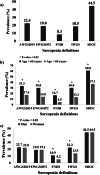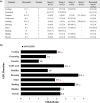Recent Sarcopenia Definitions-Variability in Prevalence and Disability Associations in Peritoneal Dialysis Patients
- PMID: 40726317
- PMCID: PMC12304736
- DOI: 10.1002/jcsm.70018
Recent Sarcopenia Definitions-Variability in Prevalence and Disability Associations in Peritoneal Dialysis Patients
Abstract
Background: Sarcopenia is common in chronic kidney disease, but no unified consensus exists regarding its diagnostic criteria. New definitions, including the Sarcopenia Definitions and Outcomes Consortium (SDOC), define sarcopenia based on decreased muscle function without measuring muscle mass. However, the application and relationship of newer definitions to functional disability in end-stage kidney disease, particularly among peritoneal dialysis (PD) patients, remain underexplored. This study evaluated the prevalence and concordance of sarcopenia using older and recent definitions and their association with functional limitations in PD patients.
Methods: This cross-sectional study evaluated Thai chronic PD patients (n = 384) with complete measurements for sarcopenia (BIA, handgrip strength and gait speed). Patients were classified according to the Foundation for the National Institutes of Health (FNIH) Sarcopenia Project, the International Working Group on Sarcopenia (IWGS), the European Working Group on Sarcopenia in Older People 2019 (EWGSOP2), the Asian Working Group for Sarcopenia 2019 (AWGS2019) and the 2020 SDOC. Functional disability was assessed using the Barthel Activities of Daily Living (ADL) score. Associations with dependency were evaluated using multivariable logistic regression.
Results: The median age was 60 years (IQR, 52-68); 54.8% were men, and 31.3% were over 65. Sarcopenia prevalence varied 5-fold: FNIH (8.3%), IWGS (18.5%), EWGSOP2 (19.0%), AWGS2019 (22.3%) and SDOC (44.5%). Using AWGS2019 as the reference, agreement was good with EWGSOP2 and IWGS but poor with FNIH and SDOC. Of 207 with sarcopenia by any definition, only 15 patients (7.3%) fulfilled all criteria. Sarcopenia prevalence was higher among older adults (≥ 65 years) across all definitions (p < 0.001). Functional limitations in at least one domain (ADL ≤ 19) occurred in 86 patients (22.4%) and were more frequent in sarcopenic patients for all definitions except IWGS. By multivariable analysis, only FNIH and SDOC were significantly associated with dependency (ADL ≤ 11): FNIH, OR 5.49, p = 0.013; SDOC, OR 6.01, p = 0.023. Using AWGS2019 component thresholds, 64.6% had low physical performance, 58.6% had low muscle strength and 22.7% had low muscle mass. Low muscle strength had a higher prevalence of functional limitation (27.1% vs. 15.7%, p < 0.05) and dependency (5.80% vs. 0%, p = 0.002) than those without.
Conclusions: Sarcopenia is common in PD patients, with substantial variability in prevalence and associations with functional limitations across definitions. Functional impairment was more frequent in low muscle strength. While SDOC was associated with functional deficits, it may overdiagnose sarcopenia in PD. Future studies using clinically relevant outcomes are needed to define sarcopenia in this high-risk group.
Keywords: chronic kidney disease; disability; end‐stage kidney disease; muscle function; peritoneal dialysis; sarcopenia.
© 2025 The Author(s). Journal of Cachexia, Sarcopenia and Muscle published by Wiley Periodicals LLC.
Conflict of interest statement
The authors declare no conflicts of interest.
Figures




Similar articles
-
POCUS ultrasound: A tool for the detection and monitoring of sarcopenia in peritoneal dialysis.Nefrologia (Engl Ed). 2025 Apr;45(4):302-311. doi: 10.1016/j.nefroe.2025.03.003. Epub 2025 Mar 27. Nefrologia (Engl Ed). 2025. PMID: 40155221
-
Sarcopenia prevalence and relationship to frailty by measurement method in patients with adult spinal deformity.J Neurosurg Spine. 2025 Jul 4;43(3):324-333. doi: 10.3171/2025.3.SPINE241551. Print 2025 Sep 1. J Neurosurg Spine. 2025. PMID: 40614274
-
Prevalence of sarcopenia in patients with chronic kidney disease: a global systematic review and meta-analysis.J Cachexia Sarcopenia Muscle. 2024 Apr;15(2):501-512. doi: 10.1002/jcsm.13425. Epub 2024 Jan 24. J Cachexia Sarcopenia Muscle. 2024. PMID: 38263952 Free PMC article.
-
Association of Oral Frailty with Physical Frailty and Malnutrition in Patients on Peritoneal Dialysis.Nutrients. 2025 Jun 6;17(12):1950. doi: 10.3390/nu17121950. Nutrients. 2025. PMID: 40573061 Free PMC article.
-
Reliability and Concurrent Validity of the SARC-F and Its Modified Versions: A Systematic Review and Meta-Analysis.J Am Med Dir Assoc. 2021 Sep;22(9):1864-1876.e16. doi: 10.1016/j.jamda.2021.05.011. Epub 2021 Jun 16. J Am Med Dir Assoc. 2021. PMID: 34144049
References
-
- Kalantar‐Zadeh K., Jafar T. H., Nitsch D., Neuen B. L., and Perkovic V., “Chronic Kidney Disease,” Lancet 398 (2021): 786–802. - PubMed
-
- Blumenkrantz M. J., Gahl G. M., Kopple J. D., et al., “Protein Losses During Peritoneal Dialysis,” Kidney International 19 (1981): 593–602. - PubMed
-
- Coletta G. and Phillips S. M., “An Elusive Consensus Definition of Sarcopenia Impedes Research and Clinical Treatment: A Narrative Review,” Ageing Research Reviews 86 (2023): 101883. - PubMed
MeSH terms
Grants and funding
LinkOut - more resources
Full Text Sources

